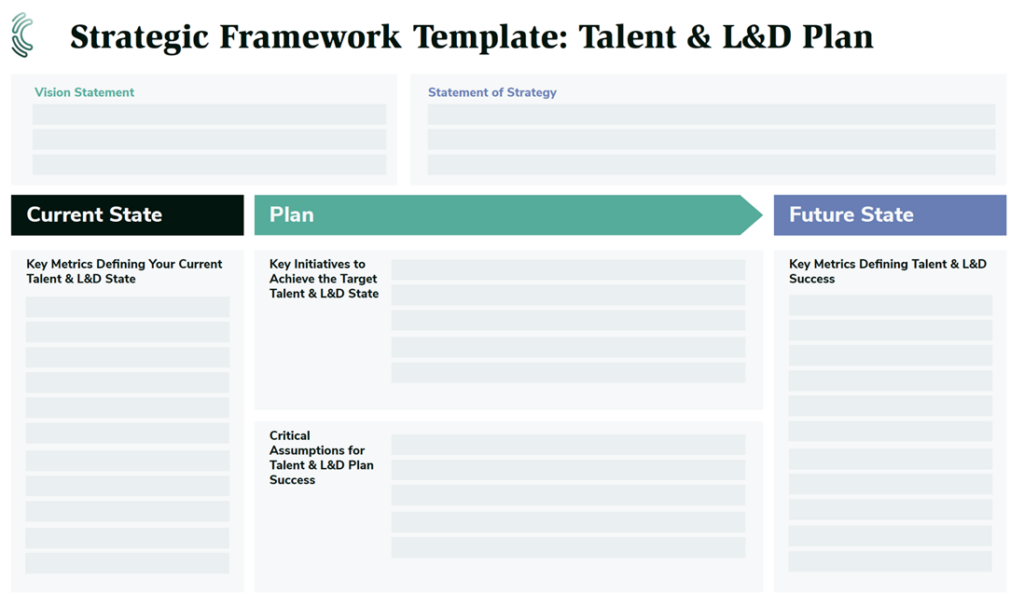🚀 Only 32% of L&D leaders have a strategy aligned with business goals—but that needs to change.
Ryan Austin shares a practical five-step plan to transform your learning strategy from reactive to indispensable. Are you ready to speak the language of the business and really make a difference? 🧠📈
Only 32% of Talent and Learning leaders say they have a strategic planning process that fully aligns with their organisation’s broader business strategy. Yet in today’s rapidly evolving world of work—where agility, innovation, and measurable impact are table stakes—that alignment is essential.
So how do L&D, Talent, and HR professionals move from reactive training to proactive business enablement? It starts with a strategic plan that connects the dots between workforce capabilities and organisational goals.
Here’s a five-step framework to help your team not only earn a seat at the table—but become an indispensable strategic partner to the business.
1. Start with the business strategy, not the learning calendar
All too often, Talent and L&D teams jump into planning initiatives without first grounding themselves in business objectives. But the most impactful strategies begin by deeply understanding the company’s goals—growth targets, digital transformation efforts, mergers and acquisitions (M&A) activity, market expansion, and more.
This step isn’t just about alignment. It’s about creating a shared language with the business, so your strategy becomes part of how the company achieves its vision—not an afterthought.
That means L&D and Talent leaders should:
- Regularly meet with senior executives to discuss their strategic priorities
- Review financial and operational reports with the CFO’s office
- Translate company objectives into actionable talent and learning needs
Think of it as becoming your organisation’s own version of Undercover Boss. In the TV show, business leaders disguise themselves and head back into the business to understand the real challenges frontline employees face—the issues you don’t see from the boardroom.
Talent leaders must do the same: embed themselves in business conversations, uncover the unspoken pain points, and see firsthand what’s really holding back performance. Because only by truly understanding what’s happening on the ground can you design strategies that don’t just sound good—but actually solve problems and drive results.
2. Define future capabilities before launching programs
What skills will your organisation need in twelve, twenty-four, or thirty-six months from now? It’s a deceptively simple question—and one that requires close collaboration with business leaders.
Let’s say your organisation’s leadership has identified a strategic priority to shift 40% of its product offerings to digital channels within the next 18 months. Here’s how that priority would cascade through the Strategy Framework:
Organisational Goal: Digitise 40% of product portfolio
This strategic objective aligns with the company’s broader push toward digital transformation and innovation.
Future L&D function and Talent needs
To support this shift, the business will require:
- Cross-functional product squads fluent in agile methodology
- User Experience (UX) design talent, whether recruited or developed internally
- Customer-facing teams upskilled in digital engagement tools
Current capabilities of the L&D and Talent function
Evaluate the current state of the L&D team and its ability to meet these future needs:
- Availability of digital upskilling programs
- Existing partnerships with agile coaches or design-thinking facilitators
- Capacity to deliver real-time learning to product and support teams
Gap assessment
Identify where current capabilities fall short:
- No agile capability in marketing or product teams
- Low digital fluency in frontline roles
- Insufficient internal resources to scale training quickly
L&D and Talent goals and success criteria
Strategic goal: Upskill 70% of product, marketing, and service teams in agile workflows and digital engagement within 12 months
Success metrics
- 25% reduction in time-to-market for digital products
- 15% increase in customer satisfaction scores
- 80% adoption of new collaboration tools within six months
Talent/Learning strategy
Design a plan that directly supports business needs through:
- Agile bootcamps with external facilitators
- Microlearning modules for digital skills
- Internal mentorship programs led by UX and product experts
- Focused enablement programs for frontline and customer-facing staff
Use interviews, department-level workshops, or surveys to identify which future skills matter most. Then prioritise based on business value and urgency.
3. Conduct a real skills inventory—not just an LMS report
Now it’s time to assess where your workforce currently stands. While many companies rely on LMS data or outdated competency models, the most effective approach includes:
- Cross-functional working sessions with department heads
- Input from people leaders about team strengths and gaps
- Use of simple frameworks to assess readiness against strategic needs
Ask: Do we have the right capabilities to deliver on key business goals? If not, what’s missing—and how do we close the gap?
This gap analysis sets the stage for defining where to invest: upskilling, reskilling, hiring, or tech enablement.
4. Co-create goals and KPIs with business partners
This is where strategy becomes operational. L&D and HR teams must work hand-in-hand with business units to co-create shared objectives, define talent priorities, and establish measurable outcomes that directly support strategic execution.
You can also look at the Alignment Process from the ROI Institute.
Here’s how that might look in the context of a company-wide shift to digitise 40% of its product offerings:
Strategic goal: Build a digitally fluent, agile workforce to accelerate product innovation.
Key Actions:
- Launch Agile learning academies in partnership with product and tech leaders
- Develop internal career paths for UX and digital roles
- Equip customer-facing teams with training on digital tools and virtual engagement best practices
- Deliver on-demand digital fluency programs for all departments involved in go-to-market
KPIs:
- 70% of product and marketing teams certified in agile workflows within 12 months
- 25% reduction in time-to-market for digital products
- 80% adoption rate of new collaboration and design tools within 6 months
- 15% improvement in customer satisfaction scores related to digital interactions
By setting goals and KPIs in direct partnership with business leaders, you ensure that L&D investments are not only aligned—but actively enabling the organisation’s most critical transformation initiatives. This level of collaboration builds credibility, secures cross-functional buy-in, and makes it easier to prioritise the right learning experiences at the right time.
5. Make the strategy visible—and make it stick
A brilliant strategy only matters if people know it exists—and believe in it.
Use storytelling techniques to tailor your message to each audience:
- Executives: Show how the strategy links to growth, innovation, or cost efficiency. Keep it high-level, data-backed, and focused on ROI
- Functional leaders: Explain how L&D will directly support their team’s goals. Use specific use cases and impact metrics
- HR and L&D teams: Break the plan into tactical steps. Assign clear ownership. Build champions
- Employees: Connect the strategy to their career development. Make it real. Make it inspiring
When done right, a well-communicated strategy becomes a rallying cry—and a roadmap for collective success.
Bring it all together: Your strategic planning canvas
A strategic plan doesn’t need to be a 50-slide deck. Use a simple framework like this to get started:
Vision statement: What future are you building for the workforce?
Statement of strategy: How will you get there? What are the key bets?
Current state: What’s working today? Where are the gaps?
Plan: What initiatives will close the gap? How will you prioritise?
Future state: What will success look like in 12-18 months?
Critical assumptions: What must remain true for this strategy to succeed?
Final thoughts: Build the strategy your business needs
In an era where talent is a company’s greatest differentiator, the L&D, Talent and HR function has never been more essential—or more scrutinised.
To lead with impact, Talent and L&D teams must evolve from service providers to strategic partners. That transformation starts with a robust, business-aligned strategy.
These five steps will help you craft a plan that not only earns a seat at the table—but helps steer the direction of your organisation’s future.
Ryan Austin is Founder and CEO of Cognota.






